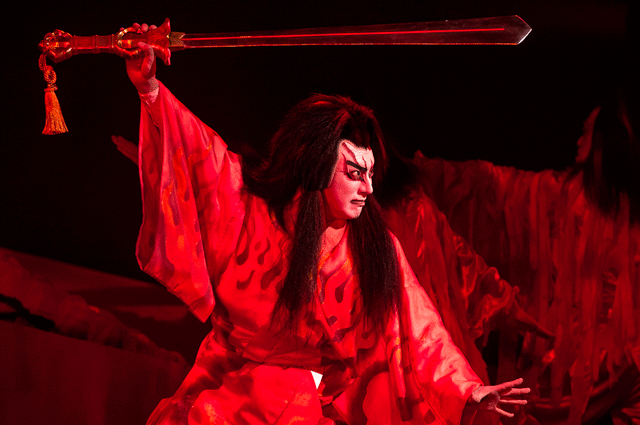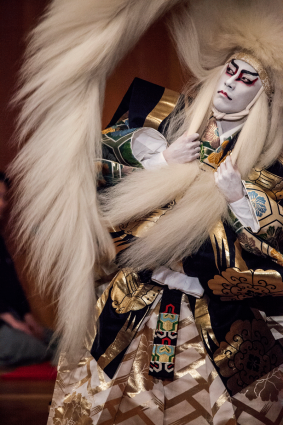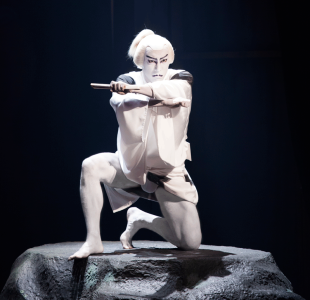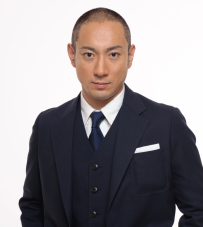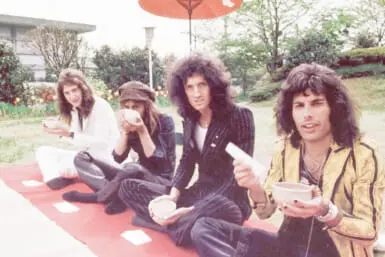“Crown Prince” of kabuki Ebizo Ichikawa prepares to dazzle the crowds at Bunkamura’s Theatre Cocoon.
The great artists of any genre combine a sense of history with a willingness to break ties with the past, and try things that have been left undared. Whether you’re talking about Miles Davis with his horn or Pablo Picasso with a paintbrush, true pioneers can challenge the old rules and redefine how the game is played. Ebizo Ichikawa is one of those artists, and the canvas on which he creates is kabuki.
Some have called the 37-year-old the “bad boy” or “wild man” of kabuki, but to do so is to forget the historical roots of this kind of theater itself. As refined as it may be now, its history has more to do with the fashion-forward kids of Harajuku than you’d think. It starts with the word itself, which can be traced back to a word (katamuku) that means “to be out of the ordinary.” In the 1500s, it was used to describe the wild dress and eccentric behavior of the bohemian set that paraded on the streets of Kyoto and Edo, as modern day Tokyo was then called. Dubbed kabukimono (“wild ones,” if you like), it was their theatrical style that inspired the name given to this new form of theater that was first performed in dry riverbeds around Kyoto, starting at the beginning of the 17th century.
Since these early Edo period counterculture days, kabuki developed into an art form that enjoyed significant popular appeal, eventually becoming one of Japan’s most highly esteemed types of theater, which was formally recognized as an Intangible Cultural Heritage by UNESCO in 2009. Over the centuries, one name that has consistently stood out as a prominent figure in kabuki history is Ebizo Ichikawa. The stage name has been handed down ten times over the centuries, almost always from father to son. The first in the Ichikawa line was the inventor of the aragoto style of kabuki, which features the grandiose gestures, exaggerated facial expressions, and bold makeup that provide the most common images of kabuki.
A New Name, A New Role
Ebizo Ichikawa XI was born into a kabuki family and first took to the stage as a professional actor when he was only six years old. He was given his first stage name, Shinnosuke VII, just two years later. His career went from strength to strength, as he spent nearly two decades performing on stage and on TV—a prominent role that he played on both was the legendary swordsman and samurai, Musashi.
In a testament to kabuki’s global appeal, Ichikawa was granted the Ebizo name at a ceremony at the Theatre National de Chaillot in Paris, during a ceremony that was described as being as elaborate as a kabuki performance itself, in 2004. Since then, Ichikawa has performed extensively overseas, in London, Amsterdam, Paris, Monaco, and Rome. Last year found him bringing kabuki, as well as noh and rakugo, to Singapore for the first time. He was awarded the Order of Arts and Letters from the French government, and has performed on the big screen, in roles that have ranged from a samurai in Takashi Miike’s “Hara-kiri” to a crewmember on a doomed WWII submarine in “Sea Without Exit.” In all of his roles, he is known for bringing a larger-than-life presence to his scenes, and for an expressive face that can convey the most tempestuous rages or touches of gentle pathos. But despite his success in the traditional world of kabuki and TV and film, Ichikawa had another challenge in mind.
Bringing Kabuki to a New Audience
Ichikawa’s wanted to take the art form back to the people who made it popular in the first place—local audiences, and the younger generation, around Japan. As Ichikawa explained, “I think that the younger generation feels a real separation from the form of kabuki. Many of them simply feel that it is too difficult for them to understand, and generally, most people have very few opportunities to come in contact with the performing arts. I want to give people a chance to step into kabuki more casually.”
His method was to create programs that featured short acts from traditional kabuki plays kabuki treatments of traditional Japanese folk tales. It was a long time in coming, but he brought his vision to reality in 2013, with a series of shows called ABKAI. Rather than playing at a large, traditional kabuki theater, Ichikawa took the show to Theatre Cocoon, Shibuya. Ichikawa took to new heights as he returned to a more traditional kabuki venue at Shimbashi Enbujo. Held aloft by wires, his airborne performance thrilled audiences as he and his company brought the famous kabuki story “Yoshitsune Senbonzakura” (Yoshitsune and the Thousand Cherry Trees) to life.
This June, Ichikawa will be returning to the modern setting of Theatre Cocoon, and bringing two of Japan’s most beloved folk tales to life: “Momotaro” and “Urashima Taro.” However, each story is given a slightly unusual spin, focusing more on the back stories. The kabuki version of Momotaro (“Peach Boy”) stays away from the adventures of the dumpling-loving boy and his animal companions and instead focuses on the “bad guys” of the story, the demons on Demon Island. His new production looks into the tensions on the island itself, and just how those demons achieved their power—a mysterious stone that fell from the sky, which was worshiped by the people and which begins to cry out in a strange voice…
Meanwhile, keeping with the star-struck theme, the retelling of Urashima Taro is also influenced by a falling star, but one whose power threatens to destroy an underwater palace, forcing the ruler of the castle Otohime (“Princess Oto”) to seek out a savior in the unwitting Urashima. For both pieces, Ichikawa will be joined by members of his past kabuki troops.
On its own, the opportunity to see kabuki in an easily accessible form would be enough of a draw, but the chance to see an artist in his prime is something not to be missed if you will be in Tokyo during the month of June. Attending one of Picasso’s early exhibits or a live show by Miles Davis might be impossible now, but being able to see one of the living legends of kabuki is well within reach, and should simply not be missed.
ABKAI 2015
Dates: June 4–21 | Ticket Prices: ¥11,000 (First Class) ¥8,000 (Second Class) ¥5,000 (Third Class)
Theatre Cocoon, Bunkamura
Dogenzaka 2-24-1, Shibuya-ku, Tokyo, 150-8507
Tel: 03-3477-9111
Web: www.bunkamura.co.jp/english/cocoon
Ichikawa Ebizo XI
Known as the “Prince of Kabuki,” Ichikawa is a specialist in playing male roles (in this art form, men play both male and female roles)
Birth name: Horikoshi Takatoshi
1983: Makes his kabuki debut at the age of six in “The Tale of Genji” (He first performed on stage one year earlier, in the U.S.)
1985: Given the kabuki name of Ichikawa Shinnosuke VII
1994: Appears on TV for the first time on the NHK drama, “Hana no Ran”
2003: Plays the starring role in the NHK drama, “Musashi.” Plays the same role on the kabuki stage that same year
2004: Given the kabuki name Ichikawa Ebizo XI
2006: Acts in his first film: the WWII drama “Sea Without Exit”
2007: Performs alongside his father, Ichikawa Danjuro, at the Palais Garnier in Paris. Is granted a membership in France’s Order of Arts and Letters
2013: Launches ABKAI series with a run at Theatre Cocoon
2014: Brings kabuki performances to Singapore for the first time
Sponsored Post

